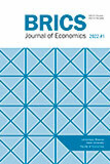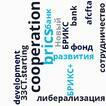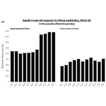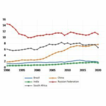In this issue

|
Papers published: 6 Total pages: 104 Printed version: Paperback Unique views: Total views: |
Go to issue
| « Previous |
Issue 5(1)
|
Next » |
Introduction to a forthcoming Special Issue in the BRICS Journal of Economics 5(2) (2024)
Since 2022 the theme of the creation of a common BRICS currency has become one of the most important BRICS-related topics in the global agenda. Many observers are starting to claim that the creation of such a currency could have transformational implications for the global monetary system – at the very least, the scope for de-dollarization that may be facilitated by the creation of a BRICS common currency may be substantial. The beneficiaries of this de-dollarization could include the currencies of the largest developing and developed economies.
In the process of launching the new BRICS currency there may be an important role to be played by the BRICS New Development Bank as well as the regional development banks, in which BRICS are members. This circle of financial institutions could pursue a de-dollarization strategy in the coming years that would improve the conditions for the launching of a common currency. Another important supporting factor could be the increase in mutual trade and investment among BRICS economies – something that is starting to be observed in the past several years. Greater trade liberalization and the pursuit of the path of the “integration of integrations” among the regional integration blocks of BRICS economies could provide an important boost to mutual trade in national currencies across the Global South.
One of the key questions at this juncture concerns the modality of the launching of the common currency. Among the possibilities is an accounting unit, a reserve currency as well as the various forms of a physical fiat transactions unit. Many market operators argue in favor of making the currency digital and backed up by gold and/or other resource assets. Whatever the eventual choice regarding the modalities of the BRICS currency, the implications for the international monetary system and global financial markets could be significant.
As for the impact of the introduction of the BRICS currency on international financial markets, there may be palpable effects on the FX market, including the dollar and the yuan exchange rates. Greater pricing in BRICS national currencies of foreign trade transactions as well as a greater use of the yuan in Central Bank reserve accumulation could also become more pronounced. All of these trends could shape the vectors of transformation of the international monetary system in case the common currency project does materialize. The latter depends on the political support for such a project from all the BRICS stakeholders – exploring the pros and cons of the project from the point of view of each of the BRICS economies may also constitute an important research undertaking in the coming years.
Yaroslav D. Lissovolik, Founder of “BRICS+ analytics”, member of the Russian International Affairs Council (RIAC)
Time frame for the Issue:
• Launch for the Call for Papers: July 17st, 2023
• Deadline for submitting a paper: January 31st, 2024
The papers should be between 5,500 and 8,000 words
For more information: https://brics-econ.arphahub.






